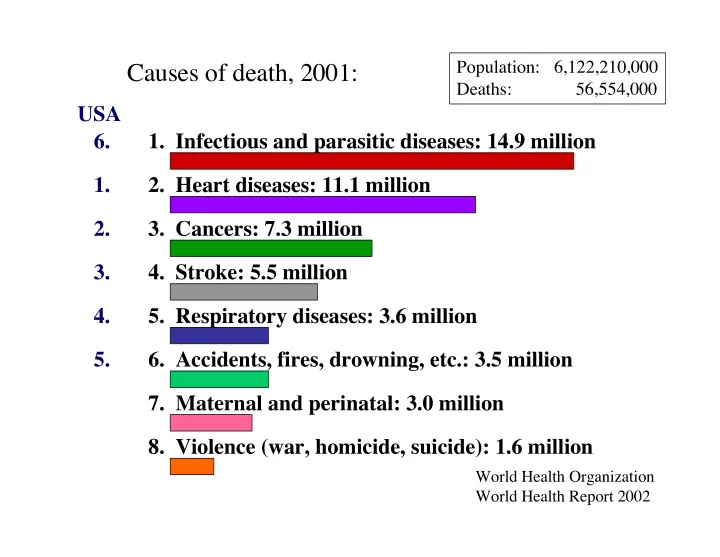

Population: 6,122,210,000 Causes of death, 2001: Deaths: 56,554,000 USA 6. 1. Infectious and parasitic diseases: 14.9 million 1. 2. Heart diseases: 11.1 million 2. 3. Cancers: 7.3 million 3. 4. Stroke: 5.5 million 4. 5. Respiratory diseases: 3.6 million 5. 6. Accidents, fires, drowning, etc.: 3.5 million 7. Maternal and perinatal: 3.0 million 8. Violence (war, homicide, suicide): 1.6 million World Health Organization World Health Report 2002
Cancer Incidence
Essential Characteristics of Cancer Cells 1. Rapid/dysregulated cell division 2. Avoid apoptosis/differentiation 3. Avoid senesence by telomere shortening 4. Genomically unstable (Mut L/S HNPCC vs. FAP) 5. Invasive 6. Survive Elsewhere (10 -3 to 10 -6 ; e.g. angiogenesis)
Genomic Instability
Break-Fusion-Bridge and Telomeres
Invasiveness and Ectopic Survival
Multiple Hits are Required/Cancer Heterogeneity
Environment versus Genetics 80-90% estimated delayable based on environmental factors! But what are they?
Oncogenes vs. Tumour Supressors
Developmental Pathways in Cancer Wnt, Hedgehog, Notch/Delta, TGF β , RTK’s
Questions: 1. 2. Does transformation require persistance of the initiating genetic perturbation?
Conventional Cytotoxic Chemotherapy
Alternate Directed Therapies 1. 2. Anti-Receptor mAb’s ( e.g. Herceptin) or soluble ligand/receptor proteins ( e.g. Avastin) 3. Kinase Enzyme Inhibitors
30 Yr. Progress: the Case for Early Detection
Human Kinome
Human Tyrosine Kinome
TK Signaling Pathways
Erb RTK Family
Erb Receptor Cancer Involvement
Erb Signaling Mechanism
Erb 1 Inhibitors
Tarceva On Erb1
Erb1 Mutations in Glioblastoma
Philadelphia Chromosome Rearrangement
Blood Cell Differentiation Pluripotent Hematopoietic Stem Cell Proeythroblast Lymphoblast Myeloblast Monoblast Megakaryoblast Neutrophil Eosinophil Basophil Reticulocyte B cell T cell Megakaryocyte Promyelocyte Erythrocyte Plasma Active Monocyte Platelets Myelocyte cell T cell Metamyelocyte Stab Cell Neutrophil Eosinophil Basophil
Abl Domains
Abl Autoinhibition
Gleevec
Gleevec Resistance Mutations in Abl
Structural Basis for Gleevec Resistance
Questions: Erb RTK K.O. in mice is embryonic lethal. Abl TK K.O. in mice induces perinatal lethality, defects of eye/head formation, and hematopoetic problems. Based on what evidence should one choose a target for inhibition?
Papers Lynch TJ, et al. (2004). "Activating mutations in the epidermal growth factor receptor underlying responsiveness of non-small-cell lung cancer to gefitinib." N Engl J Med. 350 (21):2129-39. Fabian MA, et al. (2005). “A small molecule-kinase interaction map for clinical kinase inhibitors.” Nat Biotechnol . 23 (3):329-36.
Recommend
More recommend